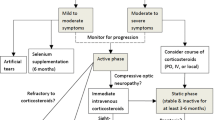Opinion statement
Thyroid eye disease (TED) is an autoimmune disease characterized by varying degrees of proptosis, congestion and inflammation of the extraocular tissues, and eyelid retraction. It is usually seen in the setting of Graves’ disease, but the severity of TED does not necessarily correlate with the level of systemic disease in a given patient. It is very important, nonetheless, to try to achieve a euthyroid state to minimize the chances of exacerbation of TED. Treatment of TED is based on the signs and symptoms displayed by the patient; there is no “one size fits all” approach. Generally, it is advisable to start with conservative measures, such as ocular lubrication with artificial tears, to manage symptoms of chronic irritation and redness. It is also imperative that the patient be advised to quit smoking, because there is a clear link between smoking and disease activity. Medical treatment with systemic oral or pulsed intravenous corticosteroids should be reserved for patients with active inflammation resulting in increased orbital pressure, compressive optic neuropathy, severe periorbital edema, or similar presentations. Once there is significant improvement in the acute inflammation, it is useful to treat patients who have residual inflammation with external beam radiation in order to be able to wean the patient off steroids and avoid their well-known complications.
If there is significant corneal exposure due to lid retraction, and the lid position has been stable for at least 6 months, eyelid surgery can be considered. If exposure is minimal, this may consist of a lateral tarsorrhaphy. For larger amounts of exposure, recession of the levator muscle, Müller’s muscle, or both can be performed. Those patients who have stable diplopia for at least 6 months are candidates for strabismus surgery. Patients who progress to severe proptosis or compressive optic neuropathy may need orbital decompression surgery. Generally, if more than one type of surgical procedure is necessary, orbital decompression is performed first, followed by strabismus surgery; eyelid surgery is performed last.
Similar content being viewed by others
References and Recommended Reading
Bartley GB, Fatourechi V, Kadrmas EF, et al.: Clinical features of Graves’ ophthalmopathy in an incidence cohort. Am J Ophthalmol 1996, 121:284–290.
Bartley GB: The epidemiological characteristics and clinical course of ophthalmopathy associated with autoimmune thyroid disease in Olmsted County, Minnesota. Trans Am Ophthalmol Soc 1994, 92:477–588.
Wiersanga WM, Bartalena L: Epidemiology and prevention of Graves’ ophthalmopathy. Thyroid 2002, 12(10):855–860.
Manji N, Carr-Smith JD, Boelaert K, et al.: Influences of age, gender, smoking, and family history on autoimmune thyroid disease phenotype. J Clin Endocrinol Metab 2006, 91:4873–4880.
Eckstein AK, Johnson KTM, Thanos M, et al.: Current insights into the pathogenesis of Graves’ orbitopathy [review]. Horm Metab Res 2009, 41:456–464.
Lee HB, Rogers IR, Woog JJ: Evaluation and management of Graves’ orbitopathy. Otolaryngol Clin N Am 2006, 39:923–942.
Aktaran S, Akarsu E, Araz M, et al.: Comparison of intravenous methylprednisolone therapy vs. oral methylprednisolone therapy in patients with Graves’ ophthalmopathy. Int J Clin Pract 2007, 61(1):45–51.
•Bradley EA, Gower EW, Bradley DJ, et al.: Orbital radiation for Graves ophthalmopathy: a report by the American Academy of Ophthalmology. Ophthalmology 2008, 115:398–409.This article provides a concise review of the available case studies and randomized controlled trials with respect to orbital radiation in TED.
Chong KKL, Khanna D, Afifiyan NF, et al.: Rituximab treatment of patients with severe, corticosteroid-resistant thyroid-associated ophthalmopathy. Ophthalmology 2009 Oct 7 (Epub ahead of print).
Disclosure
No potential conflicts of interest relevant to this article were reported.
Author information
Authors and Affiliations
Corresponding author
Additional information
Papers of particular interest, published recently, have been highlighted as:
• Of importance
•• Of major importance
Rights and permissions
About this article
Cite this article
Phillips, M.E., Marzban, M.M. & Kathuria, S.S. Treatment of Thyroid Eye Disease. Curr Treat Options Neurol 12, 64–69 (2010). https://doi.org/10.1007/s11940-009-0054-0
Published:
Issue Date:
DOI: https://doi.org/10.1007/s11940-009-0054-0




